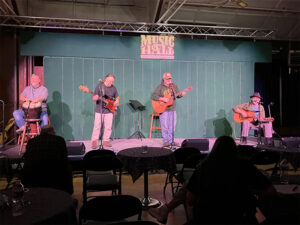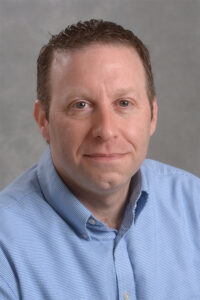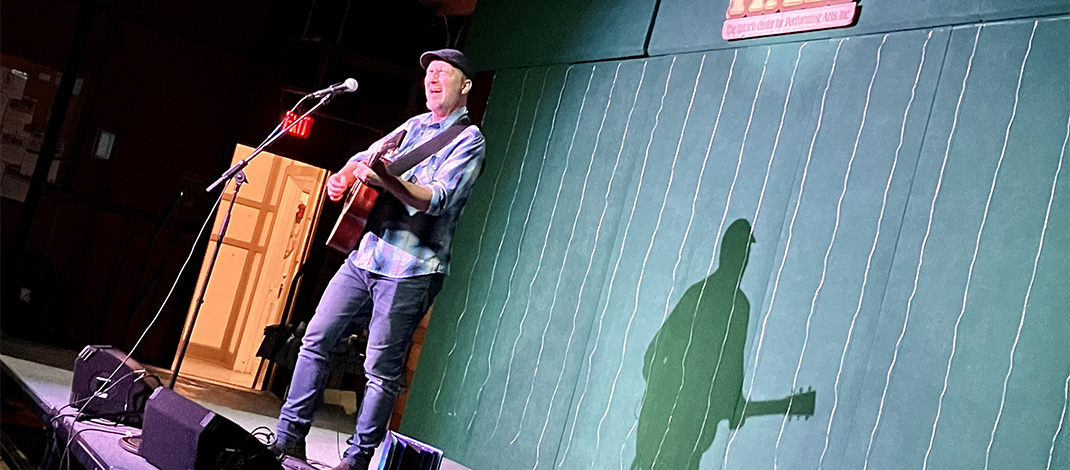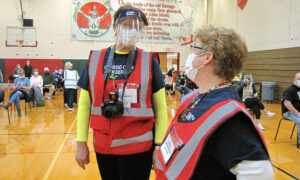Organization approaches 50 years as a venue for local performers
by Tim Nekritz nekritz@gmail.com

For any arts organization to survive nearly a half-century, at least two threads are important: a focus on community and a willingness to evolve.
These are both true of the Oswego Music Hall, which continues providing entertainment, opportunities and a sense of belonging in the Roy C. McCrobie Building in Oswego on a bluff overlooking Lake Ontario.
Mark Wahl has seen and, often in succeeding decades, led the changes since the organization’s informal origin in the 1970s.
The official story dates its beginnings to Richard Reinert opening a coffeehouse venue known as the Lowlife Cafe in 1976 in the building most known today for housing Old City Hall.
Performing in what became known as the Market House Music Hall, the movement coalesced into its official organization, the Oswego Music Hall, in 1979.
“In its days before its incorporation, I was in that community of people that performed back then and hung out,” Wahl recalled. “It was a casual type thing where people stood up and did a piece.”
Those roots — the casual nature, the sense of invitation and inclusion — continue as part of the organization’s DNA even as it has grown and diversified its offerings.
The Oswego Music Hall is perhaps best known for its National Stage, which brings a variety of performers who have developed a buzz in musical circles — which this year ranged from Sawyer Fredericks (winner of the eighth season of NBC’s “The Voice”) to the bluegrass and Celtic fusion of The McKrells to folk troubadour Peter Mulvey to Grammy-nominated bluesman Guy Davis and many flavors in between.
That lineup of national headliners every other Saturday night during fall, winter and spring dates back more than 40 years. “I was fortunate to be involved with some of the icons of the early music scene,” Wahl notes, recalling such influential luminaries as Dave Bromberg, Greg Brown, Tom Rush, Dave von Ronk, Utah Phillips and many more bringing their talents to Oswego.
The layout offers a homey, coffeehouse vibe. Walk into the McCrobie Building’s ballroom, and you’ll find a layout dominated by round tables with small candles on them. Refreshments, especially before COVID-19, offered baked goods and other items at prices that are reasonable.
If necessary, organizers can move in more chairs and fewer tables if a show is expected to draw larger numbers. Wahl said the ballroom could hold up to 200 if needed, but however large the crowd attending, the ambience remains an intimate one enjoyed by performers and audience members alike.
An estimated 19,000 volunteer hours make it happen, working on everything from professional-level technology and logistics to setting up and taking down the venue.
“We’ve got some wonderful volunteers that put in a lot of work for a good cause,” Wahl said. “That kind of thing is one of the true secrets to feeling good about your life, where you take your time and devote it to something good. When you can find something that is meaningful to devote to that helps others, you feel like your valuable time is well spent.”
Showcasing community
A decade ago, the organization went back to its roots by adding Friday open mics the evenings before the national shows. A Central New York performer serves as host, helping to bring in their own fans, complementing a loyal core of local singer–songwriters and other performers.
“It adds interest to the game and we have a community that really likes to perform there,” Wahl said. “They get professional sound, they get a stage with great lighting and it’s a great listening room. It’s economical and smart.”
A recent Friday featured a range of talent — those who have been performing for decades, newer and emerging singer–songwriters and even 14-year-old blues–rock phenom Mira Grimm who would introduce current originals as well as ones she wrote “back in middle school about middle school drama.” That evening’s host, local favorite Marc Warner, let everybody play three songs and then offered everybody an opportunity to play a couple more if they wanted.
The Music Hall also offered an additional spotlight for singer–songwriters by launching The Hook series in 2015.
“I wanted to do this new program, with songwriters going round robin,” Wahl said. “After a year as a pilot, it was pretty well adopted. It’s very well accepted by performers. Every performer would bring an entourage and their fans.”
The vitality of the regional scene has been the main planning impediment to it, in terms of scheduling.
“To get three people on a stage on a given date and do it multiple times throughout a season is a challenge,” Wahl said, crediting “some really great directors over the years.” Oswego-based performers John McConnell and Cam Caruso currently coordinate the series.
Expanding the circle
As a grassroots cultural organization, the Music Hall often relies on funding from partners like the New York State Council on the Arts (NYSCA). In addition to financial support, NYSCA tries to ensure organizations are reaching broader audiences and aiming for inclusion.
“One thing desired not only by us but by granting agencies like NYSCA is diversity,” Wahl said. “We should be learning about the bigger picture and introducing ourselves to really cool stuff we don’t know much about.”
A NYSCA suggestion led to what Wahl and others find an exciting development, the Guest Curator Series that launched in 2022. The first year of the program saw two successful installments in the FIRE (Females Inspire Rock Inspire) Festival, coordinated by CNY performer Jess Novak, and the Jazz by the Lake Series, curated by David Kasper.
The FIRE Festival featured not only a stellar daylong lineup of female singers but vendors showcasing women-owned businesses.
“All of a sudden we’ve become more aware of some great women artists in the area, mixed it in with other art,” Wahl said. “And for the jazz series, Dave [Kasper] knows all about jazz all over New York state, and many of the great jazz players in our proximity.”
It provides a win-win in terms of fresh ideas, funding worthy efforts and providing fresh options for audiences.
“You find the curator, let them spin a great idea, figure out how you’re going to help them do it,” Wahl said. “Through this program, we’re seeing ideas that generate from outside our own board. It can bring new and younger audiences. It’s healthy for us, it expands our community. It brings to our stage a program that someone else directs and all we do is coach them.”
The road ahead
While Wahl has rotated off the board, and remains involved as a volunteer, he’s excited about the people still on it, including the new board president, his wife Ellen. “She’s a far better administrator than I am,” he said.
He’d love to see the organization strengthened by providing salaries or stipends to some key positions to complement the strong core of volunteers.
The technical aspects of the venue continue to get better. “Through money from Shineman Foundation and other places, we’ve graduated to a larger and more professional sound, better lighting, and we’ve gone digital for sound and lighting,” Mark Wahl said.
“The better our tech is, the better the performance, the better the audience can hear it, the better the reaction, which improves the performance even more,” Wahl said. “It’s a circle. When it all works right, they all deserve the standing ovation, as does the tech crew.”
He also noted the Music Hall has developed a great relationship with SUNY Oswego for interns who learn how these events run while also bringing their technical skills to the table.
Wahl also credited Oswego Mayor Billy Barlow and his administration for being great partners in the city-owned building, which includes making some additional space available.
“The city has been really supportive through Mayor Barlow and that administration,” Wahl said. “They have been fabulous. We’re working with them for a room for upstairs events in the McCrobie Building. A place we can have jams, artist receptions and events when we don’t have the main space. We can have lessons, we can have meetings.”
In addition to upcoming shows from country/folk/rocker Jonathan Byrd (April 15) and family folk act The Burns Sisters (April 29), one thing that organizers and fans alike look forward to is the seasonal grand finale in May, which this year features dynamic folk duo Annie Sumi and Travis Knapp on May 13.
The finale is more than a concert; it’s another opportunity to bring together the sense of community that this (or any) conversation with Wahl will come back to regularly. It includes a buffet dinner and time for volunteers and fans to have one more big gathering before the busy summertime event schedule draws them in various directions.
Whatever evolutions come as the organization approaches 50 years of music, Wahl knows that the sense of community and the vibrant volunteer force will keep things going.
“We have a community of people who like to be part of it, who like to make it happen,” Wahl said. “Along the way, they realize: ‘This is ours. We’re making this happen, and I’m important in the process.’”
For more information, visit oswegomusichall.org.
 TIM NEKRITZ is director of news and media for SUNY Oswego, where he spearheads telling the stories of the campus community.
TIM NEKRITZ is director of news and media for SUNY Oswego, where he spearheads telling the stories of the campus community.



